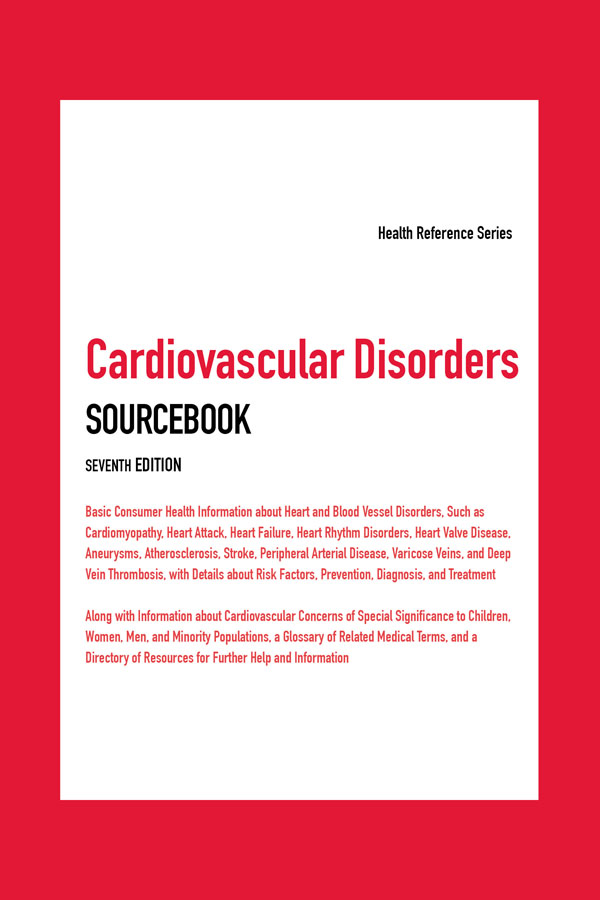Cardiovascular Disorders
SOURCEBOOK
SEVENTH EDITION
Health Reference Series
Cardiovascular Disorders
SOURCEBOOK
SEVENTH EDITION
Basic Consumer Health Information about Heart and Blood Vessel Disorders, Such as Cardiomyopathy, Heart Attack, Heart Failure, Heart Rhythm Disorders, Heart Valve Disease, Aneurysms, Atherosclerosis, Stroke, Peripheral Arterial Disease, Varicose Veins, and Deep Vein Thrombosis, with Details about Risk Factors, Prevention, Diagnosis, and Treatment
Along with Information about Cardiovascular Concerns of Special Significance to Children, Women, Men, and Minority Populations, a Glossary of Related Medical Terms, and a Directory of Resources for Further Help and Information

Bibliographic Note
Because this page cannot legibly accommodate all the copyright notices, the Bibliographic Note portion of the Preface constitutes an extension of the copyright notice.
* * *
OMNIGRAPHICS
Angela L. Williams, Managing Editor
* * *
Copyright 2019 Omnigraphics
ISBN 978-0-7808-1707-4
E-ISBN 978-0-7808-1708-1
Library of Congress Cataloging-in-Publication Data
Names: Omnigraphics, Inc., issuing body.
Title: Cardiovascular disorders sourcebook: basic consumer health information about heart and blood vessel disorders, such as cardiomyopathy, heart attack, heart failure, heart rhythm disorders, heart valve disease, aneurysms, atherosclerosis, stroke, peripheral arterial disease, varicose veins, and deep vein thrombosis, with details about risk factors, prevention, diagnosis, and treatment; along with information about cardiovascular concerns of special significance to children, men, women, and minority populations, a glossary of related medical terms, and a directory of resources for further help and information.
Description: Seventh edition. | Detroit, MI: Omnigraphics, Inc., [2019] | Series: Health reference series | Includes bibliographical references and index.
Identifiers: LCCN 2019013868 (print) | LCCN 2019014308 (ebook) | ISBN 9780780817081 (ebook) | ISBN 9780780817074 (hard cover: alk. paper)
Subjects: LCSH: Cardiovascular system--Diseases--Popular works.
Classification: LCC RC672 (ebook) | LCC RC672.C35 2019 (print) | DDC 616.1--dc23
LC record available at https://lccn.loc.gov/2019013868
Electronic or mechanical reproduction, including photography, recording, or any other information storage and retrieval system for the purpose of resale is strictly prohibited without permission in writing from the publisher.
The information in this publication was compiled from the sources cited and from other sources considered reliable. While every possible effort has been made to ensure reliability, the publisher will not assume liability for damages caused by inaccuracies in the data, and makes no warranty, express or implied, on the accuracy of the information contained herein.

This book is printed on acid-free paper meeting the ANSI Z39.48 Standard. The infinity symbol that appears above indicates that the paper in this book meets that standard.
Printed in the United States
Table of Contents
Chapter 2Risk Factors for Cardiovascular
Disorders
Section 2.1Coronary Heart Disease
Risk Factors
Section 2.3Targeting Cardiovascular
Disease Risk Factors May Be Important across a Lifetime
Section 3.1Depression and Heart
Disease
Section 3.2Diabetes and
Cardiovascular Disease
Section 3.3High Blood Pressure and
Heart Disease
Section 3.4High Cholesterol and
Heart Disease
Section 3.6Sleep Apnea and
Cardiovascular Disease
Section 3.7Stress and Cardiovascular
Disease
Chapter 6Recent Research Regarding
Cardiovascular Disease Risks
Section 6.1Disrupted Sleep May Lead
to Heart Disease
Section 6.2Eating Red Meat Daily
Triples Heart
Disease-Related Chemical
Section 6.3Risk Factors for Heart
Disease Linked to Dementia
Section 6.4Too Little Potassium May Contribute to
Cardiovascular Disease
Section 6.5Consumers Missing Out on
Health Benefits of Seafood Consumption
Chapter 7Warning Signs of Cardiovascular
Emergencies
Section 7.1Signs and Symptoms of a
Heart Attack
Section 7.2Signs and Symptoms of
Cardiac Arrest
Section 8.1What to Do during a Heart
Attack
Section 8.2Emergency Treatment of
Cardiac Arrest
Chapter 9Role of Automated External
Defibrillator (AED) in Cardiac
Emergencies
Section 26.2Peripheral Arterial Disease
of the Legs
Section 27.2Varicose Veins and Spider
Veins
Section 30.1Basic Facts about
Congenital Heart Defects
Section 30.2Kawasaki Disease:
A Disorder with
Cardiovascular Implications
Section 30.3Rheumatic Heart Disease
Is More Common in
Children than in Adults
Section 31.1Women and Heart Disease:
A Statistical Overview
Section 31.4Menopause and Heart
Disease
Section 32.2Cardiovascular
Implications of Erectile Dysfunction
Chapter 33Cardiovascular Disease in Minority
Populations
Section 33.1Cardiovascular Disease
among U.S. Racial and
Ethnic Minorities: Some
Statistics
Section 33.3American Indian and
Alaska Native Heart
Disease and Stroke
Section 33.4Heart Disease in the
Hispanic Population
Chapter 34Recognizing Signs and Symptoms of
Heart Disease
Chapter 36Blood Tests Used to Diagnose
Cardiovascular Disorders
Chapter 48Medications for Treating
Cardiovascular Disorders
Chapter 49Procedures to Treat Narrowed or
Blocked Arteries
Section 49.4Coronary Artery Bypass
Grafting
Section 49.5Stents to Keep Coronary
Arteries Open
Chapter 50Procedures to Treat Heart Rhythm
Disorders
Section 50.1The Cardioversion
Procedure
Chapter 51Procedures to Treat Heart Valve
Problems
Chapter 56Rehabilitation after Heart Attack or
Stroke
Section 57.2Preventing Heart Disease:
Other Medical Conditions
Section 62.1Dietary Supplements:
What You Need to Know
Chapter 63Other Interventions to Help Reduce
Risk of Cardiovascular Disease
Section 63.1Aspirin for Reducing Your
Risk of Heart Attack and
Stroke
Section 63.2Heart Disease and Adult
Vaccines
Section 63.3Influenza Vaccine May
Reduce Cardiovascular
Disease Risk
Chapter 64Glossary of Terms Related to
Cardiovascular Disease
Chapter 65Directory of Resources Providing
Information about Cardiovascular
Disease
Preface
About This Book
Cardiovascular disease is the leading cause of death in the United States. According to the Centers for Disease Control and Prevention (CDC), 735,000 Americans suffer a heart attack and 610,000 people die of heart disease in the United States every year. Additionally, coronary heart disease (CHD) is the most common type of heart disease, killing over 370,000 people annually. Yet, cardiovascular disease is often preventable. With careful attention to diet; an active lifestyle; and control of contributing factors, such as diabetes, cholesterol levels, blood pressure, tobacco use, and weight, Americans can reduce their chances of facing heart disease, stroke, or other blood vessel disorders. Furthermore, advances in our understanding of how to treat cardiovascular conditions make it possible to reduce the disabling health consequences frequently associated with these disorders.





